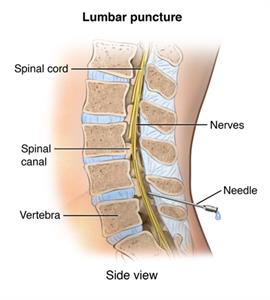How Ro Explain Pseudo Tumor Center to Family
Idiopathic Intracranial Hypertension
Not what y'all're looking for?
What is idiopathic intracranial hypertension?
Idiopathic intracranial hypertension (IIH) is a disorder related to loftier force per unit area in the brain. Information technology causes signs and symptoms of a brain tumor. It is likewise sometimes called pseudotumor cerebri or benign intracranial hypertension.
The fluid that surrounds the spinal cord and brain is called cerebrospinal fluid or CSF. If too much fluid is made or not plenty is re-absorbed, the CSF tin can build upwardly. This can cause symptoms like those of a brain tumor.
IIH is classified into these categories:
- Acute. Symptoms happen suddenly, often because of a head injury or stroke.
- Chronic. Symptoms develop over time. They may exist caused by an underlying health problem.
- Idiopathic. The cause isn't known.
What causes idiopathic intracranial hypertension?
Experts don't know why IIH occurs. Some medicines have been linked to a higher risk of it. These include mutual medicines like:
- Birth control pills
- Certain antibiotics
- Chemotherapy drugs
- Steroids
- Some acne medicines
What are the symptoms of idiopathic intracranial hypertension?
The symptoms of IIH mimic those of a true encephalon tumor. The principal sign is unusually high pressure within the skull. This is known as intracranial hypertension.
Other symptoms include:
- Changes in eyesight such as blurry vision or double vision
- Vision loss, especially in the peripheral vision
- Feeling dizzy or nauseated
- Vomiting
- Neck stiffness
- Trouble walking
- Frequent headaches, frequently along with nausea or vomiting
- Persistent ringing in the ears (tinnitus)
- Forgetfulness
- Depression
These symptoms may look like other health problems. Ever see your healthcare provider for a diagnosis.
You may find that certain symptoms increase when you're exerting yourself. Do tends to raise the pressure in the skull.
Who is at adventure for idiopathic intracranial hypertension?
Anyone can develop IIH. Merely some people are at college risk for it, such as:
- Women of childbearing age (20 to 45 years)
- Overweight people
- People who accept a thyroid condition or chronic kidney failure
How is idiopathic intracranial hypertension diagnosed?
A physical exam and a few tests can help identify IIH. Diagnosis involves ruling out other health problems, including a encephalon tumor. You lot may need these tests:
- Encephalon imaging such as MRI or CT scans
- Spinal tap (lumbar puncture) to withdraw a sample of fluid from around the spine for testing force per unit area
- Exam to test vision and bank check the dorsum of your heart

How is idiopathic intracranial hypertension treated?
Handling can vary based on what is causing the fluid to build upwardly inside the skull. Handling options include:
- Losing weight, if needed
- Limiting fluids or salt in the diet
- Surgically putting a special tube (shunt) in the brain to drain fluid and ease pressure
- Having a spinal tap washed to remove fluid and reduce pressure
- Taking medicines, such as water pills (diuretics). These help the body to become rid of extra fluid.
- Having surgery on the optic nervus to ease pressure and save vision
What are possible complications of idiopathic intracranial hypertension?
Untreated IIH can effect in permanent problems such as vision loss. Have regular center exams and checkups treat any middle problems before they get worse.
Information technology's likewise possible for symptoms to occur again even later treatment. It'south important to get regular checkups to aid monitor symptoms and screen for an underlying problem.
Tin idiopathic intracranial hypertension exist prevented?
Obesity has been linked to IIH. So eating a salubrious, low-fat diet and getting plenty of practice may help reduce your risk for the condition.
When should I call my healthcare provider?
Any changes in vision should be checked out by a healthcare provider right abroad. Diagnosis and handling can assistance prevent long-term complications such as vision loss.
Cardinal points about idiopathic intracranial hypertension
- Idiopathic intracranial hypertension is a disorder related to high pressure in the brain.
- Fifty-fifty though IIH isn't a brain tumor, it can nonetheless cause serious wellness bug.
- Seeing a healthcare provider correct away to promptly diagnose symptoms and begin treatment tin can help to prevent complications.
- Eating a healthy, low-fat diet and getting enough of exercise may aid reduce your risk for IIH.
Next steps
Tips to help you go the most from a visit to your healthcare provider:
- Know the reason for your visit and what yous want to happen.
- Before your visit, write downward questions you lot want answered.
- Bring someone with you to help you ask questions and remember what your provider tells yous.
- At the visit, write down the proper name of a new diagnosis, and any new medicines, treatments, or tests. Also write downwards any new instructions your provider gives yous.
- Know why a new medicine or treatment is prescribed, and how it will help you. Also know what the side effects are.
- Enquire if your condition can be treated in other ways.
- Know why a test or process is recommended and what the results could mean.
- Know what to expect if you do not have the medicine or have the test or procedure.
- If you have a follow-upwardly date, write down the date, time, and purpose for that visit.
- Know how you tin can contact your provider if y'all accept questions.
Not what yous're looking for?
Source: https://www.cedars-sinai.org/health-library/diseases-and-conditions/p/pseudotumor-cerebri.html
0 Response to "How Ro Explain Pseudo Tumor Center to Family"
Post a Comment